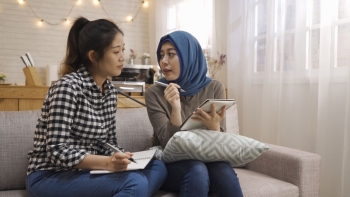
Using a Relationship Smorgasbord to Manage Relationship Expectations
Relationships can be confusing. Most of us have preconceived notions of what types of things are included in a friendship vs romantic relationship vs business partnership, which are based on real-life models, media portrayals, and societal standards. When we have different relationship expectations from another person and do not make those explicit, we often run into problems that lead to arguments and frustration on both sides. However, talking about our expectations, making them clear, and airing out our feelings and frustrations in an open-minded and compassionate way leads to increased connection, intimacy, and relationship satisfaction. This tip will give you a tool borrowed from relationship anarchists that helps to clearly define relationship expectations in any sort of partnership.
Relationship anarchy is a system of beliefs in which no one type of relationship is valued above another just because of its label (e.g., romantic relationships are not prioritized over friendships or family relationships just because they usually include sex and/or cohabitation). In fact, it often bucks labels in favor of letting each relationship simply be what it is on a case-by-case basis. This system encourages open, direct communication, consent, and autonomy within all relationships. The nature of relationships can and should be negotiated, and renegotiation can happen at any time if all parties are not satisfied. Partners of all sorts are expected to communicate freely about their feelings. Relationship anarchy is often described under the umbrella of polyamory, as it allows people to form natural, authentic connections with others without having to limit or restrict what behaviors are part of new relationships based upon labels of existing ones.
Part of the issue in managing relationship expectations are the labels themselves. For example, when we label someone a “partner,” we might make assumptions about what that type of relationship will entail; perhaps we expect that a partner will be someone we rely on for emotional support, be someone we are romantic with, be someone we are sexual with, and eventually be someone with whom we cohabitate. However, this may not be the case for everyone - there are plenty of partnerships out there that are nonsexual, that do not involve living together, etc. It is important to define what your specific partnership will entail in order to manage those expectations and avoid disappointment or resentment if the other person does not want the exact same elements as you do in a relationship. The same is true for friendships, sexual partners, play partners, business relationships, families, and more - defining what to expect in a relationship will help to avoid heartache down the line.
Whether you are defining a new relationship or an existing one, you can borrow concepts from relationship anarchy in order to clearly define each of your and your companion’s relationship expectations. The most important concept is clear, honest conversation about what each of you want from the relationship. Taking that first step toward asking for what you want can be nerve-wracking, but luckily there is a tool that can help you to begin this conversation. Included below is the Relationship Smorgasbord. It appears to have been created by some relationship anarchist friends and posted to a Reddit polyamory forum. The idea is that you have a smorgasbord of different relational elements that can be included in different types of relationships, and you and another person get to choose collaboratively exactly what you’d like to include on your collective relationship platter.
One way to use the relationship smorgasbord is to sit down with the other person in the relationship and consider all of the items listed. Each of you should have your own sheet. You can use different colors to indicate your level of interest in each of the items. For example, you can circle items in green that you are very enthusiastic about including in the relationship, yellow for things you would consider but are not sure about, and red for things you definitely do not want to be part of the relationship. Then, compare your sheets. If you both circled something in green, great! This can definitely be a part of your relationship, and you can talk about how you’d like that to look. Here’s an example of how that could go:
“I noticed we both circled emotional support in green. We can definitely include that in our relationship. How would you like me to show up for you emotionally? Are there any boundaries you have around this? How can I let you know if I need to change the type or frequency of emotional support I am giving to or receiving from you?”
You should do this with every element that you decide to include. Clearly defining these relationship expectations is the main point of the exercise and will help you with communication and understanding one another down the road.
If one of you has something circled in green and the other has it in red, that element will not be part of your relationship. You may have a conversation about it, but it is important to respect the feelings and boundaries of the person with whom you are building or defining the relationship.
If one person has something circled in green or yellow and the other person has it in yellow, there is more room for negotiation here. You can discuss your reservations about the item; what parts of it you would be excited about including; and how you may modify the item to work for your particular relationship. Again, it is important to define what the expectations are around this element. For example, if you are both hesitant about becoming collaborative or business partners, it would be essential to lay out how you would work together, identify what some potential pitfalls of that relationship would be, and how you would work through conflict. Then, if you both decide it’s worth it, it can become part of your relationship.
The relationship smorgasbord is meant for all types of relationships - platonic, familial, romantic, sexual, etc. - and is indeed meant to challenge and make clear exactly what we mean when we are using these descriptors. For example, friendship does not look the same for everyone. For some, it may include friendship, emotional support, and being social partners. For someone else, it may include those elements and also emotional intimacy, sexual touch, and being collaborative partners. The point is that you and the other person in the relationship get to decide and define precisely what will and will not be included in your relationship, and there should be nothing left ambiguous. This will help both of you to manage your expectations of yourselves and each other in your relationship.
It is also important to note that once you decide on what elements will be included in your relationship, that does not mean it can never change. It just means that if one of you wants to add or subtract anything on the relationship smorgasbord, that you should approach the other person and have a conversation about whatever it is you’d like to change. It can sometimes be anxiety-inducing to talk about changing the nature of a relationship, but the smorgasbord gives you an easy shorthand to start that conversation. Something as simple as, “Hey! I’d like to take another look at what’s included on our relationship platter. When would be a good time for you?” might feel much easier than starting with, “I’d like to discuss the nature of our relationship.” Having regularly scheduled check-ins about your relationship and time to process also helps diminish anxiety around this discussion.
If you would like help with managing relationship expectations, contact a therapist at https://www.therapyinphiladelphia.com/contact.
f you need help determining which therapist might be a good fit for you, or you want morning hours (6am-12 noon), very late evening hours(8-10pm), or specific weekend times, group therapy or you have an unusual situation call (215) 922-LOVE and speak to the intake coordinator or call the founder of the organization Alex Robboy (267) 324-9564 to discuss your particular situation. Most of our therapists offer more hours than what is posted online, some appointment time slots can only be scheduled by calling us. We have a wide range of therapists at The Center for Growth / Therapy in Philadelphia.
There are 17 therapists at the Center for Growth. We each have our own unique area of expertise. Between the 17 of us, we pretty much cover every topic. Not all of us do everything. Additionally, our own backgrounds shape how we see the world. We have Black therapists, Asian therapists, Caucasian therapists, Male therapists, Female Therapists, GLBT therapists, Jewish therapist, Christian therapists, and Muslim therapists, married therapists, single therapists, mom therapists, doctoral and masters level therapists, old therapists and young therapists. To find the right therapists for you, please feel free to read the therapists biographies or call and speak with one of us today.















